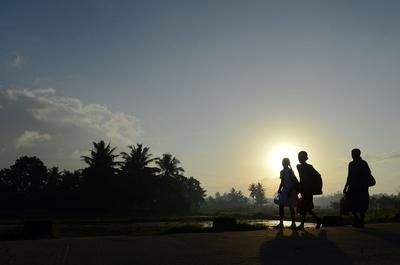From 2006 onwards the government had championed rapid infrastructure improvement for rural Sri Lanka. The decisive win of the United People’s Freedom Alliance also helped to remove a recurring constraint on the economic front: fragile coalitions that often stymied reform efforts. For the new government, there was greater pressure to deliver ‘an economic peace dividend’, a vision reiterated in its own policy stance on post-conflict reconciliation. The latter mostly involved improved economic services and opportunities for the conflict-affected regions — and made little effort to heed calls for a greater decentralisation of political and economic power.
The government has set itself ambitious economic targets; it aims to achieve GDP growth of 8 per cent or above, and double Sri Lanka’s per capita income to US$4,000 by 2016. By headline numbers, there has been a remarkable turnaround relative to the low-growth economic equilibria of the conflict-affected decades. GDP growth averaged 7.6 per cent during 2010–12, pulling down unemployment to 4 per cent in 2012, and halving absolute poverty to 8.9 per cent between 2006 and 2010. Unlike many earlier episodes of higher growth, poverty reduction this time went hand in hand with better equity outcomes across the country.
Such linear extrapolations, however, do not factor in policies, the role of government, and the state of markets and regulatory institutions that will determine long-term growth dynamics. Sri Lanka’s growth story during 2006–12 is one that has been driven by an ambitious public investment-led infrastructure program. From 2006, public investment was upped to 6–6.5 per cent of GDP, relative to a low share of 4 per cent previously. This has created public assets and pushed money into the economy, with all its multiplier effects. Decades of neglect and the need to boost growth partly justify the approach. However, the results have come at a cost, and suggest that factors that spur growth at one phase of development might well impede it at another.
Infrastructure financing is expensive. Sri Lanka has opted to rely on costly foreign borrowing, from both international financial markets and bilateral partners, especially China. Tellingly, the share of high-cost external debt has risen from 7.3 per cent in 2006 to 50.5 per cent in 2012. As a result, the economy stands more exposed to external shocks today, as its foreign debt grows, but foreign direct investment is stagnant, and exports are seeing a sharp decline. The export share of GDP dropped to 16 per cent in 2012, from 28 per cent in 2004. This is not surprising given that growth has skewed towards non-tradable sectors on the back of a large infrastructure drive.
Easier, albeit more costly, access to foreign borrowing has also stymied efforts at domestic resource mobilisation. Government revenue remains depressingly low at 13 per cent of GDP in 2012, well below the 20 per cent threshold for low middle-income economies such as Sri Lanka. Public investment in sectors such as health and education has been neglected, and there is rising concern that unless Sri Lanka’s skills gap is addressed, the benefits of current investment in physical infrastructure will not pay off.
Underpinning the infrastructure drive has also been a trend towards greater state control over resources, including through state-owned enterprises, monopoly control of industries, and the financial sector. As the role of the state in an economy expands, it often means that the beneficiaries are those close to state power. If this is not effectively managed, transparency and accountability mechanisms and the establishment of solid and durable institutions weaken.
Of special concern is that with the infrastructure drive delivering growth, the policy agenda for necessary economic reforms has been neglected. Education reforms to enhance access to, and the quality of, education; reforming labour markets to reduce rigidities; deregulating and/or restructuring the public utilities sector, especially the energy sector; and overhauling the country’s tax system remain unaddressed. This is despite a political class with an enviable electoral mandate — stronger than at any time in Sri Lanka’s recent history.
The imperative to accelerate economic growth in post-conflict Sri Lanka prompted an ambitious public infrastructure program. But even as it continues to meet its targets, Sri Lanka is in danger of lulling itself into a sense of complacency. Ongoing developments in the euro zone offer a salutary lesson and a necessary reminder of the choices available to governments. Economic growth can be given a short- to medium-term boost by fiscal and/or monetary policy stimulus, but at the risk of worsening long-term debt problems. For Sri Lanka, too, unless a sustained economic reform effort accompanies infrastructure investment, sustainable and stable long-term growth and development may prove elusive.
Dushni Weerakoon is deputy director and head of macroeconomic policy research at the Institute of Policy Studies, Sri Lanka.

